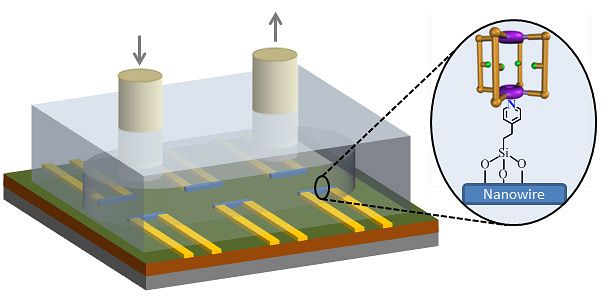Dutch researchers have developed a nanosensor that selectively measures low concentrations of TNT molecules. They published their results in Nano Letters from the American Chemical Society.
About two years ago, two young researchers, Anping Cao (TU Delft) and Dr. Wei Zhu (University of Twente and now Sandia National Laboratories, USAPhilips), had a bright idea: why not combine molecular cages with electronic nanowire sensors into a super selective molecular sensor?
When a target molecule, in this case, the explosive TNT, slots into the molecular cage, it changes the local charge density which changes the current through the silicon nanowire.
Measurements show that the current changes with the logarithm of the TNT concentration. One nanomol per litre (of ethanol), equivalent to 1 part per billion, is about the threshold value.
Whether this threshold is sensitive enough to sniff out explosives at airport inspections, Dr. Louis de Smet (TU Delft Faculty of Applied Sciences and Wageningen University & Research) cannot tell. He said the concentration in air cannot be directly translated into fluids.
The team had to test the sensor with alcohol solutions because air and especially moisture is detrimental to the molecular cages. Built up from four organic ligands between two metal ions, these self-assembling structures are very sensitive to water.
Fully organic structures would be less sensitive to moisture, but then again they don’t have the same self-assembling features that make the metal-organic polyhedra (MOPs) so attractive for constructing nanocages.
The big advantage of molecular cages is their selectivity: larger molecules don’t fit in and other small molecules don’t make the right connections within the cage.
Dr. De Smet expects that receptors like these molecular cages will prove to be useful as selective absorbers of sodium or potassium ions. Or for absorbing phosphates from waste streams.
Researchers Anping Cao and Dr. Wei Zhu did the experiments. Dr. Jin Shang (University of Melbourne and City University of Hong Kong) took care of the mathematical modelling. Dr. Johan Klootwijk (Philips), Professor Jurriaan Huskens (University of Twente), Professor Ernst Sudhölter (TU Delft) and Dr. Louis de Smet were the supervisors. The projects was funded by NanoNextNL and NWO.
Anping Cao, Wei Zhu et. al, Metal-Organic Polyhedra-Coated Si Nanowires for the Sensitive Detection of Trace Explosives, ACS Nano Letters, November 9 2016, DOI: 10.1021/acs.nanolett.6b02360




Comments are closed.